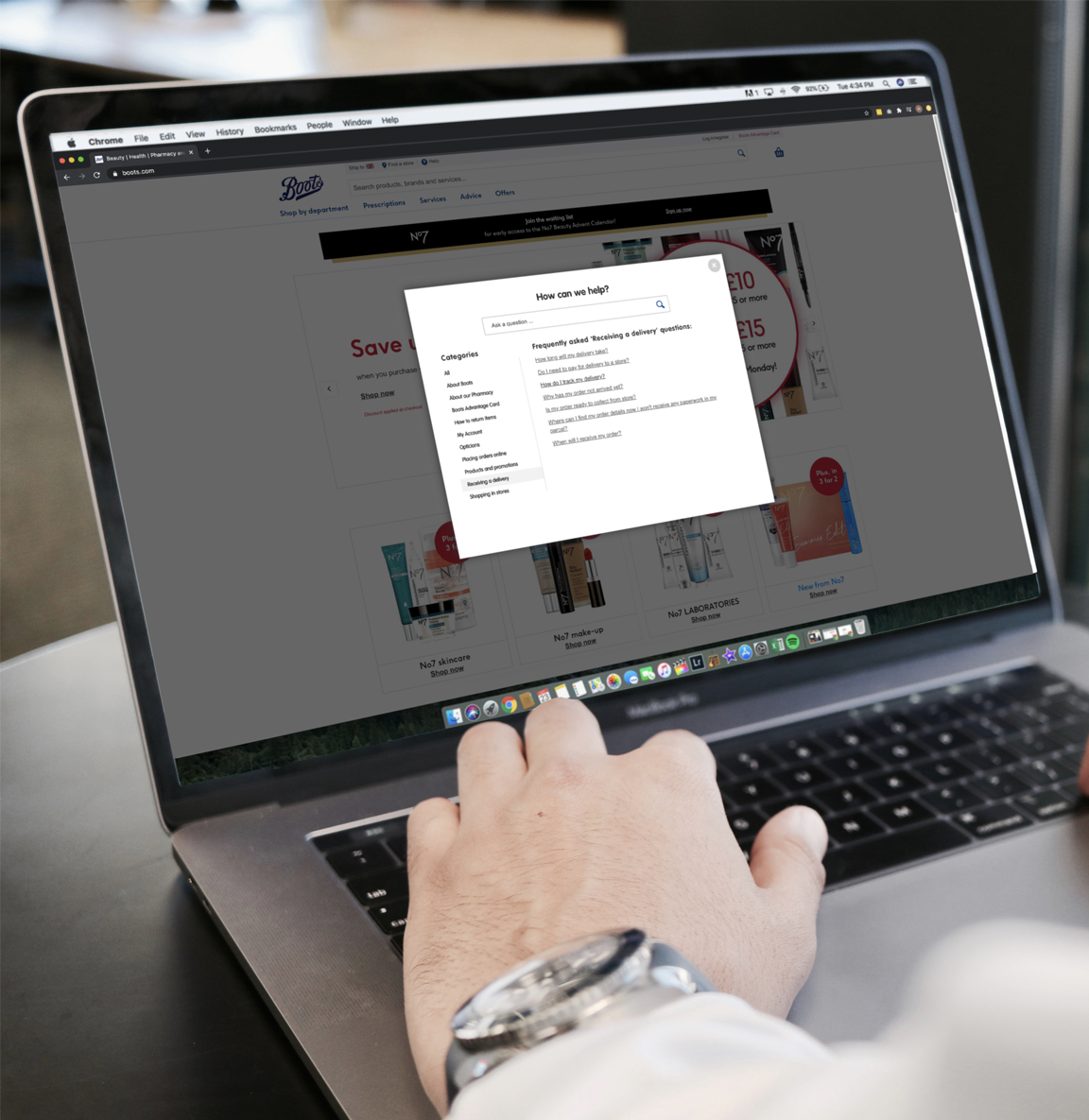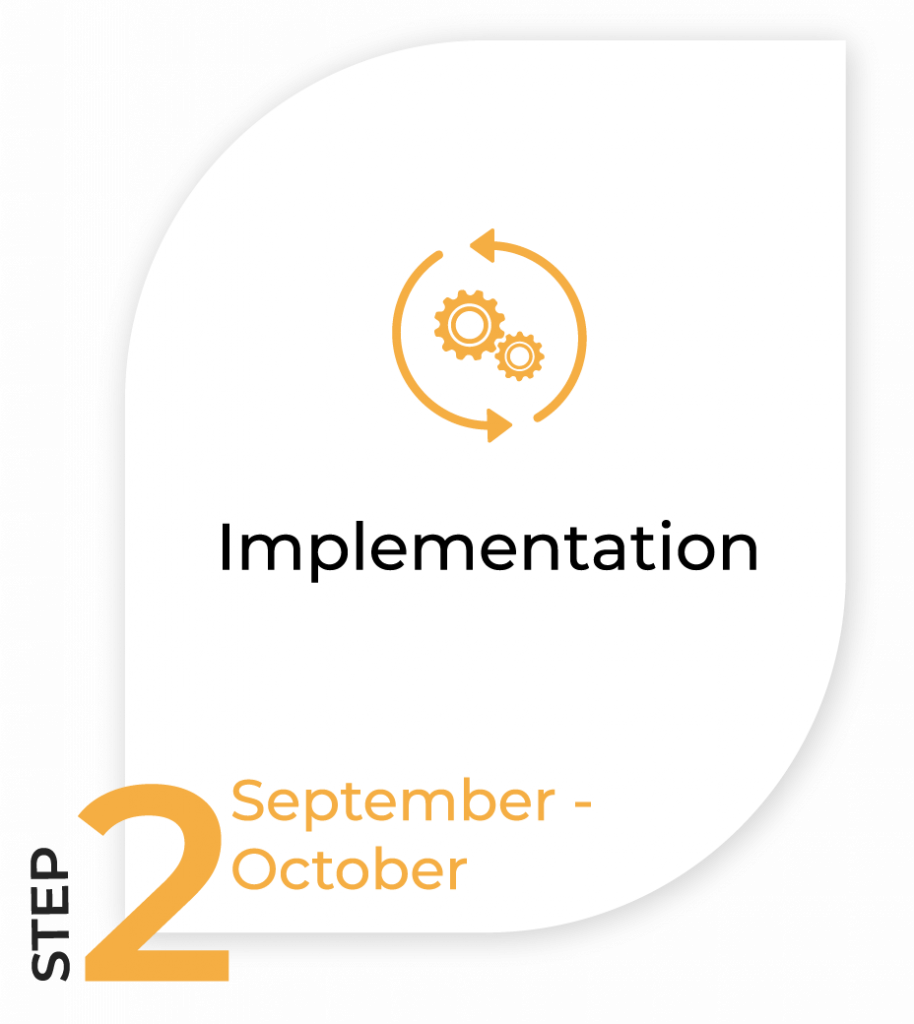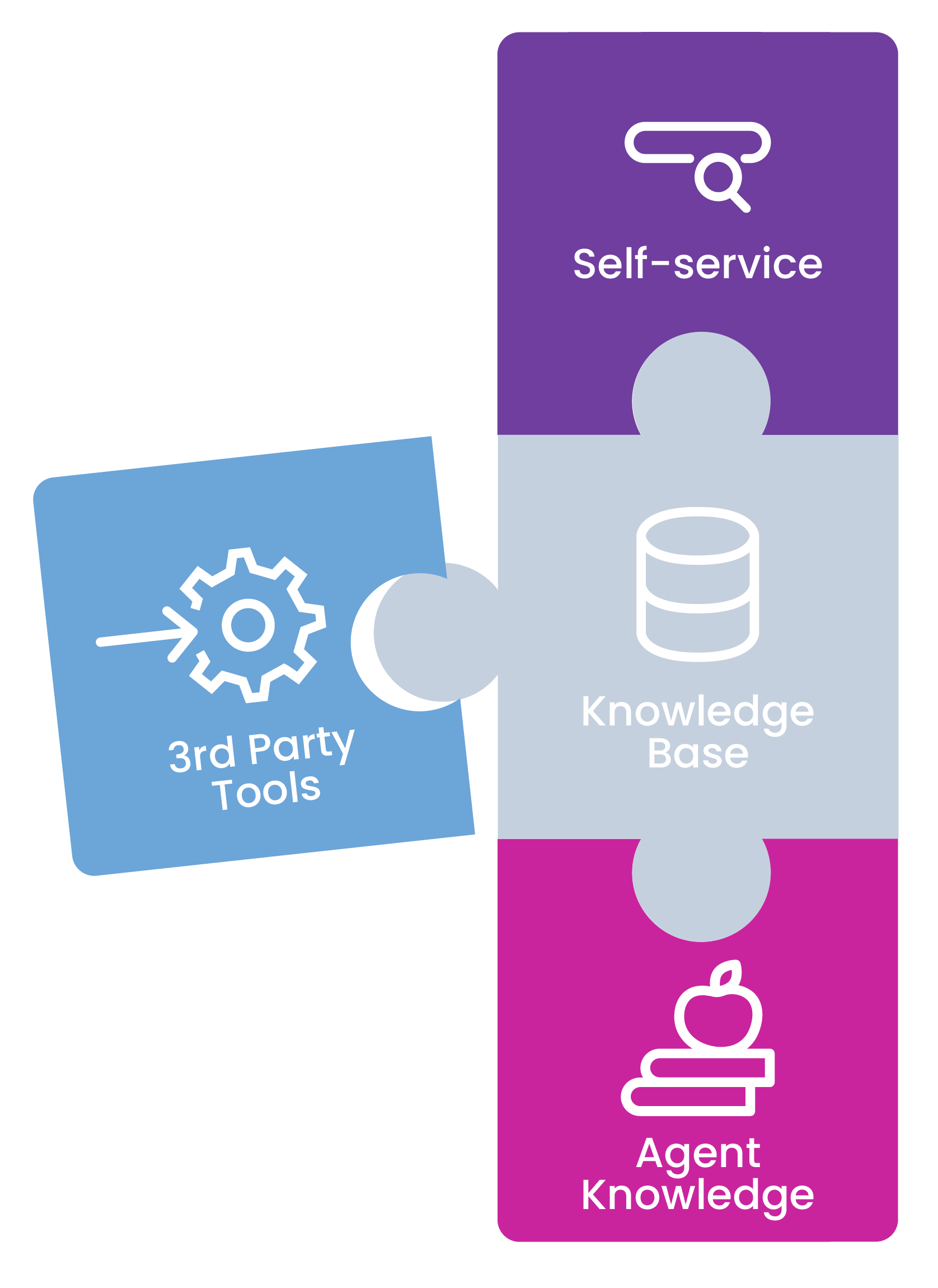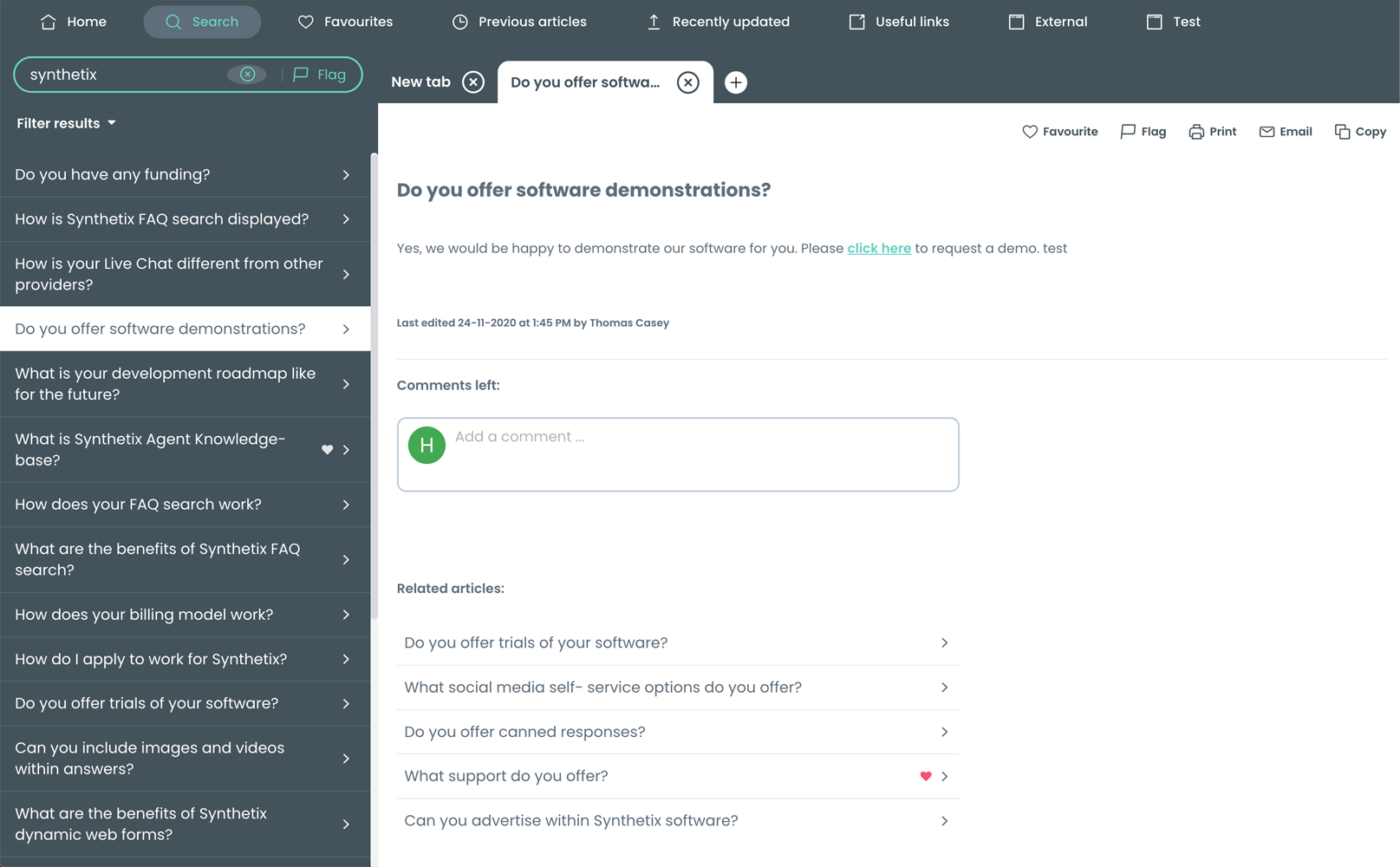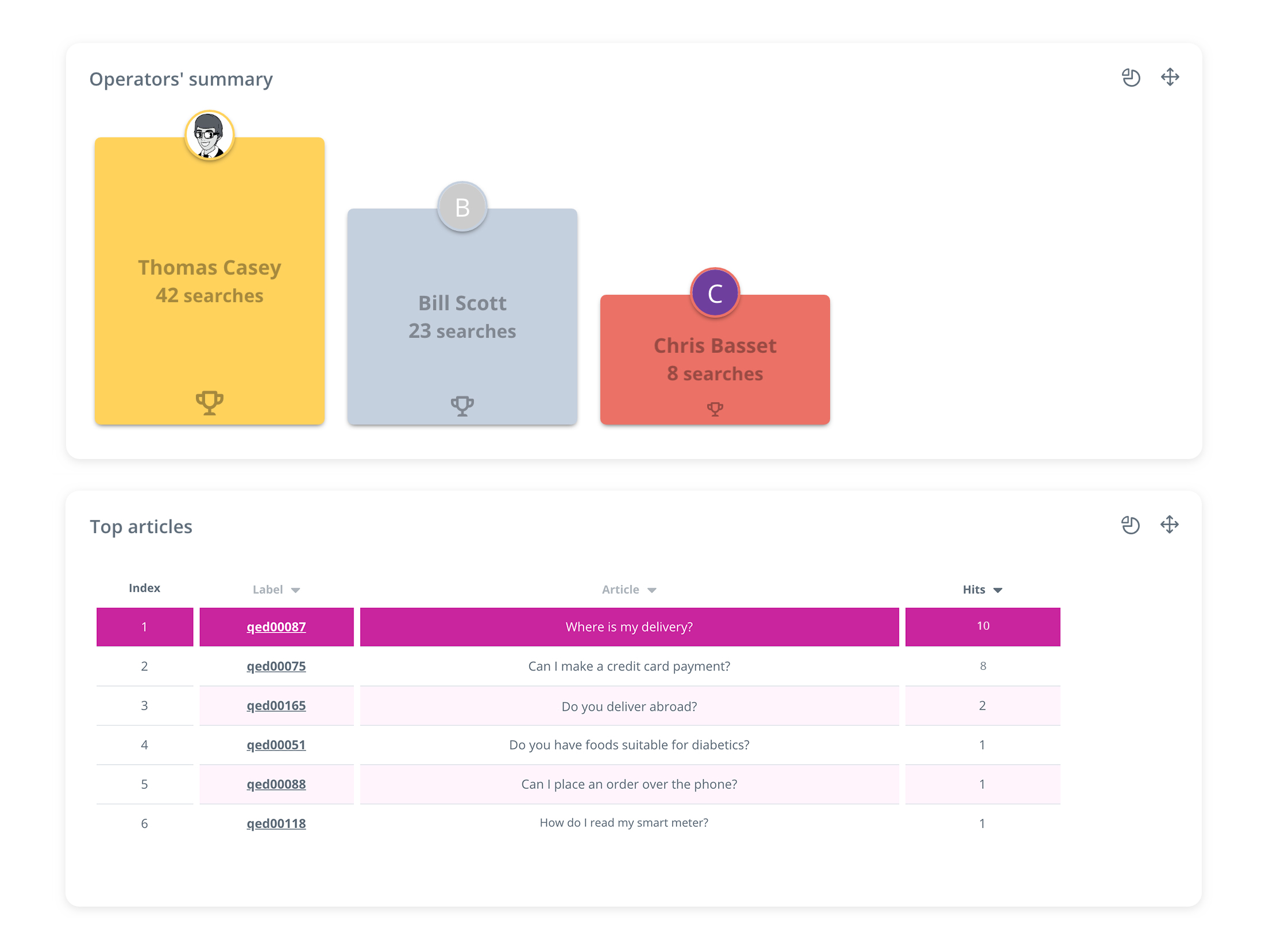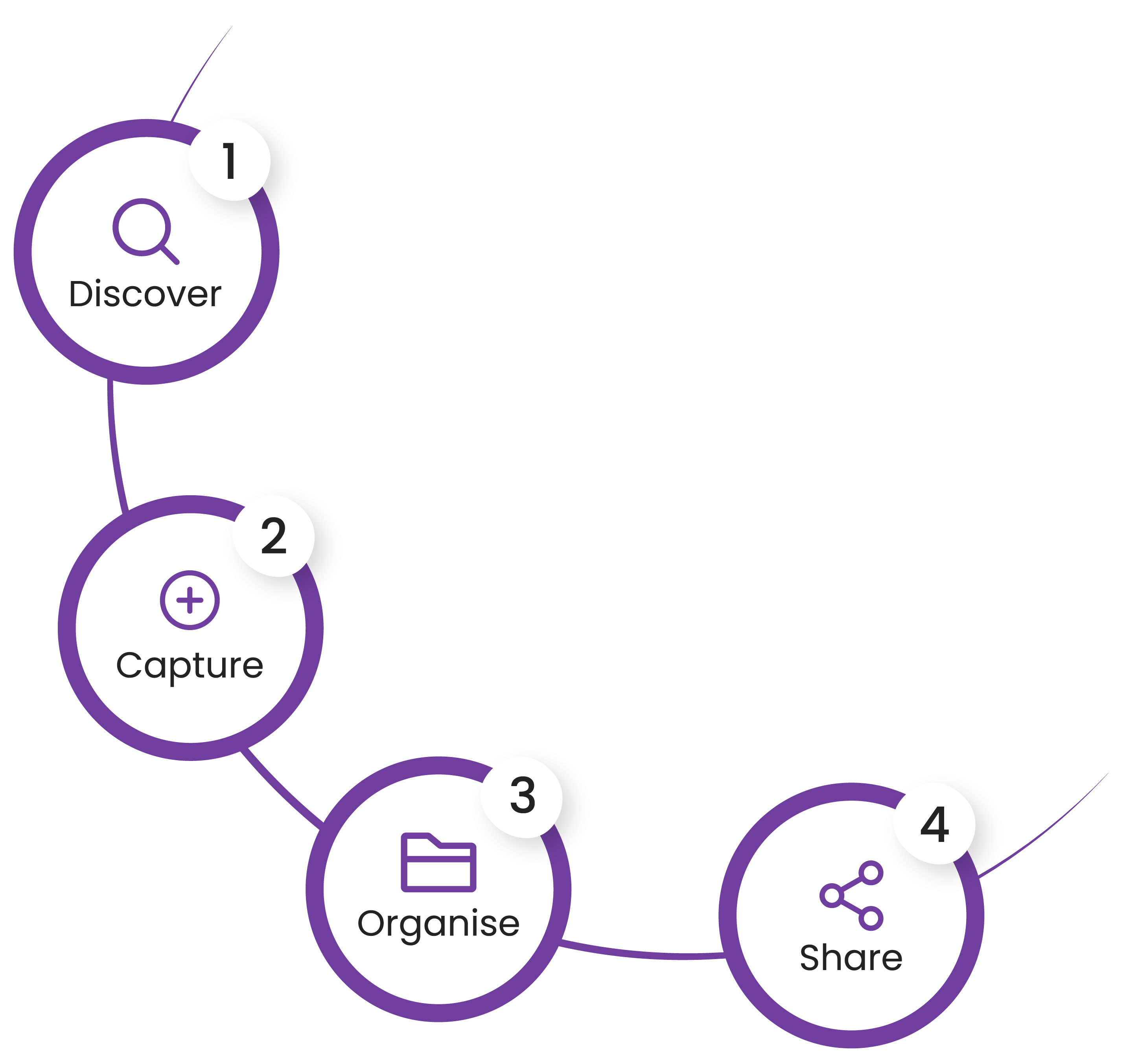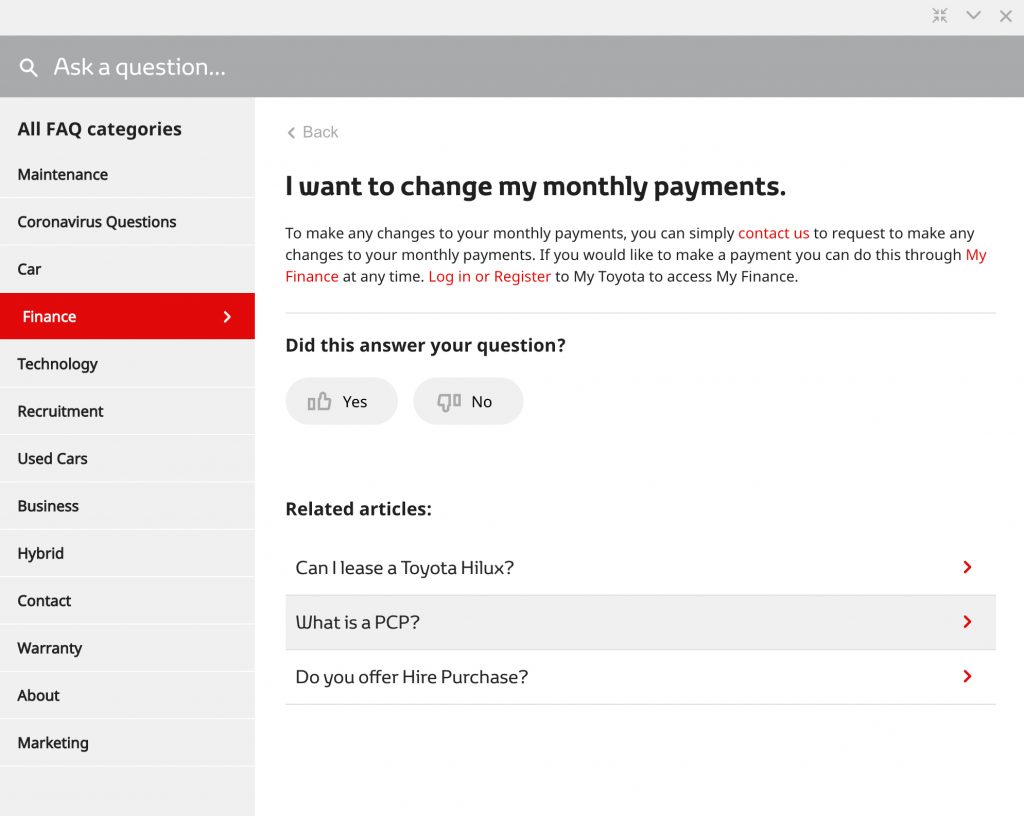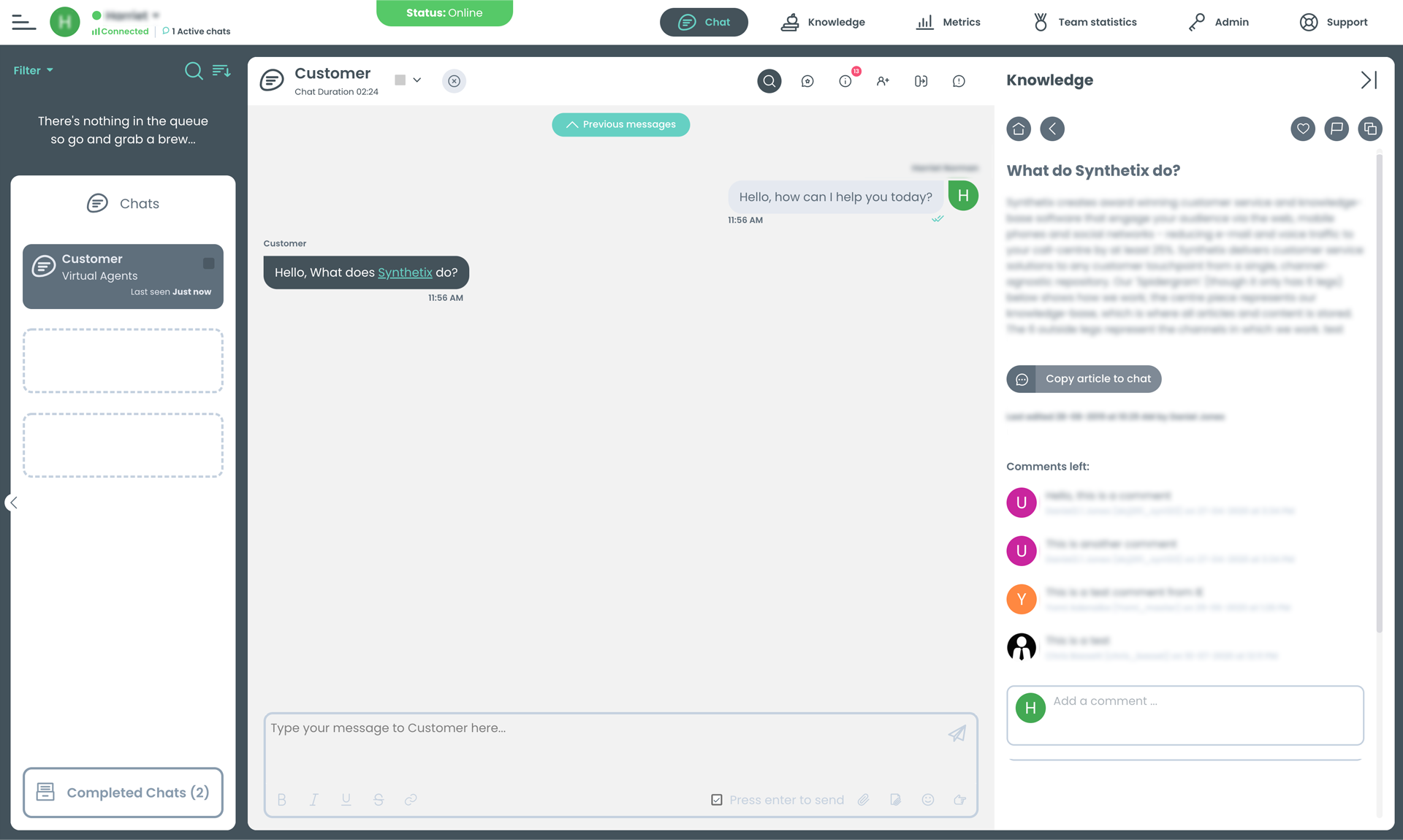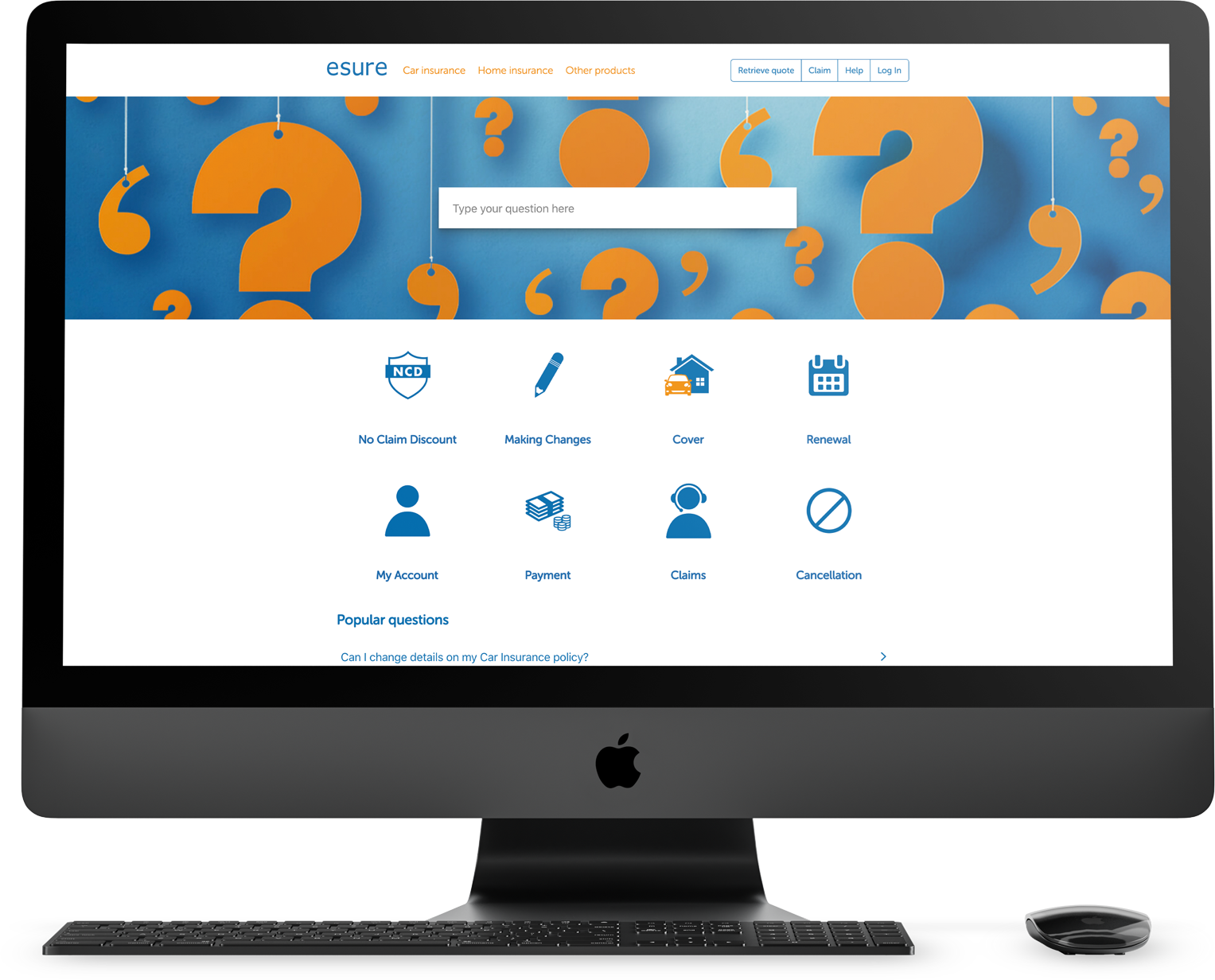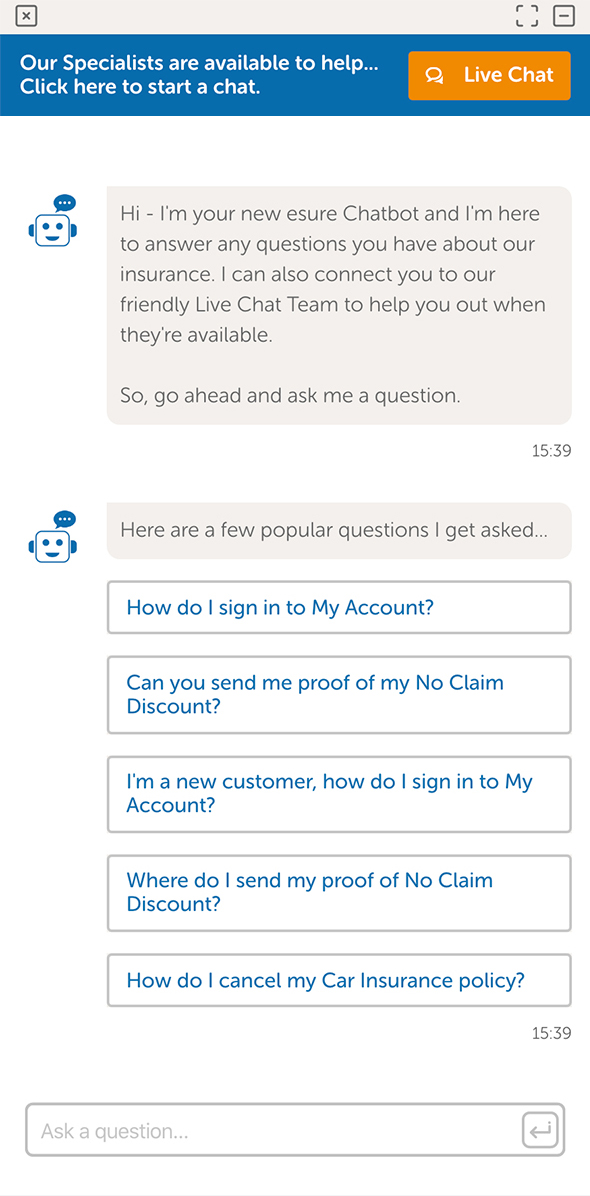Self-service technologies include a number of forms, such as:
- A help section on your website
- An interactive knowledge base
- A chatbot
Optimised for convenience and usability, these tools allow customers to find the answers to their own questions, quickly and with ease.
Unlike other contact channels that involve customers liaising with support agents, such as live chat , email or phone, self-service software provides the support that customers, who want to be proactive require to resolve their own queries.
Customers engage with self-service software when they would like to find out more information, answer a query of troubleshoot an issue. This will generally relate to a product, service or the company itself. The software is built upon AI using Natural Language Processing (NLP) and Machine Learning (ML) principles to understand naturally phrased questions and have the ability to match relevant questions with answers.
An intelligent Knowledge base
Self-service software connects to a customer-friendly version of a wider knowledge base to deliver customers accurate and consistent information on every occasion. A knowledge base contains thousands of articles that include everything from company return policies to opening hours, troubleshooting videos to terms and conditions – sophisticated technology serves customer relevant results based on what is typed into the self-service search bar.
Not only is web self-service a key tool for facilitating good customer service, but it is an imperative part of the wider customer journey. If a customer has a question or issue that needs solving, it is likely that they will self-serve before ascending to other forms of contact. In fact a study by Microsoft revealed that 66% of customer will engage with self-service first rather than immediately talking with an agent.
Why Is Self-Service Software So Important Today?
The customer self-service software market is estimated to grow from USD 4.33 Billion in 2016 to USD 9.38 Billion by 2021, at a Compound Annual Growth Rate (CAGR) of 16.7% during the forecast period.
Self-Service Is the Key to Efficient Customer Service Operations
Growing contact volumes are a huge challenge for customer service and contact centre teams. Increasing support queries are putting a huge strain on support teams and agents unnecessarily, flooded with routine questions, they cannot focus their full attention on complex customer queries. This in turn can affect resolution times and quality, causing them to drop and customer satisfaction to suffer.
The reason that self-service software is currently so valuable to customer service teams is that is mitigates contact significantly. It can automate the entire question and answer process for a huge segment of customers, allowing agents to sufficiently deal with those in need.
Read: The Top 5 Benefits Of A Self-Service Contact Centre
Changing Customer Needs and Expectations
Customers’ needs and the way in which they engage with customer service is frequently changing, it’s one of the reasons why so many companies incorporate self-service options into their customer service offering; to build adaptation into their customer service front-lines.
It is becoming increasingly common for customers to consult a search engine or website for answers before reaching out to a support agent. In fact, a study by Synthetix revealed that 90% of consumers will always check a website before e-mailing or calling a company to find information.
Customers want the freedom to serve themselves and find out information on their own terms. There is a reason that self-service has been normalised for simple day-to-day operations such as paying for shopping, checking in for a flight and even self-ordering in restaurants. It has become many customers’ preference, and the same applies to online customer service. So much so that more than 90% of consumers expect organisations to have an online customer self-service offering. To ensure customers remain satisfied, companies must react to their needs and offer web self-service options.
We live in an increasingly fast paced world. As humans we are doing more at a quicker rate – customers are interacting with brands more, purchasing more, returning items more and subsequently, expecting more. A pwc study revealed that speed and convenience mattered most to customers, each hitting over 70% in importance when it came to experience. Fast solutions have become an everyday expectation for customers, which is why self-service software, that is easy to use, provides answers instantaneously and is available 24/7 is in such high demand.
Millennials and Gen Z prefer Self-service
Millennials (born between 1980 – 1995) and Gen Z (born between 1996 – 2012) now make up over 60% of the worldwide population. Having grown up in the digital age with smartphones, e-commerce and broadband, the internet is a comfortable place for them – and this applies to their customer service habits. Millennials and Gen Z would prefer to help themselves than engage with a support agent. A recent study revealed that 75% of millennials would rather use self-service and avoid picking up the phone.
Millennials and Gen Z, who constitute a significant portion of your customer base are self-reliant, expect things ‘on-demand’ and like to answer their own questions – it even makes them “feel good” when they can solve a problem solo. This generation has particularly high expectations when it comes to customer service – they want convenience, flexibility and instant answers – but most importantly, they are the future and companies should be catering to their preferences.
Shift in Digitisation
There has been a steady shift in digital transformation over the last decade, making online versions of shopping, banking and even counselling available and convenient for anyone to use. But are we moving towards a time where everything will be digitised?
External challenges like the shift in digitisation along with additional pressures such as those related to the COVID-19 crisis are causing customers to visit brick and mortar establishment less and less. The impact of which means consumers turn to digital substitutes for their needs, including costumer service. Consumers no longer visit physical businesses to solve problems, seek help or complain, just like their business transactions, they do it online. This is why self-service is effective, it simplifies things for the customer, but also alleviates the pressure put on support teams who are feeling the burden of a recent upward trend in online support requests.
What Are the Benefits of Using Self-Service Software?
Improved CSAT
A study by Microsoft revealed that 95% of respondents cited customer service as important in their choice of loyalty to brand, with 61% having switched brands due to poor customer service.
All too often customers are unnecessarily kept waiting in line for long periods of time to speak to support agents, subsequently causing frustration. This can easily be avoided using a self-service offering. Not every customer who is on hold needs to be there – which is why it’s vital that a ‘do it yourself’ option is available and accessible to avoid not only disgruntled customers, but strain on customer service.
Serving customers quick, accurate answers using a easy to navigate solution, can help build a lasting relationship between you and your customers and as a result, positively impacts your CSAT scores.
Reduced Operational Costs
Supermarkets that utilise self-service checkouts save operational costs by requiring fewer employees to oversee and assist customers – and the same applies to online customer service.
Self-service software helps to automate routine queries and by doing so the volume of support tickets, phone calls, emails and live chats are considerably reduced. This means employees spend less time dealing with routine questions and therefore the backlog is reduced, cutting operational and staffing costs significantly.
It can also impact operational efficiency positively, for example by reducing Average Handling Times (AHT). Because self-service is designed to deal with routine queries, time that agents would have otherwise spent answering high volumes of FAQs is significantly reduced. Self-service ultimately allows customer service to offload an entire category of enquiries, giving them greater capacity to dedicate more time to solving complex customer issues.
Consistent Answers
The beauty of self-service software is that it connects to the same library of knowledge that the entire customer service team consults when dealing with customers. The results that are served to the customer are pulled from your company knowledge base using sophisticated algorithms and AI.
This ensures that all answers that are delivered to your customers are consistent with the company and accurate. Companies that do not utilise the same source of knowledge across teams and contact channels risk providing inconsistent or inaccurate answers that could significantly harm their company and reputation.
Human-like Understanding
Self-service software utilises AI-powered Machine Learning (ML) so that it can learn from every customer interaction. This helps identify any errors, learn terminology and grammar and also serve the most popular answers in order to optimise customer experience.
Natural Language Processing (NLP) is also used to help self-service software understand exactly what the customer is asking, using algorithms, it takes into consideration the keywords, intent, grammar and popularity of the question. This way the software can correctly respond to customers’ naturally phrased question, similar to how a human would.
Enhanced Customer Experience
Online customer experience has never been more important, with expectations higher than ever, customers want a smooth journey to their resolution, without roadblocks that create frustration.
With two thirds of customers preferring to first try solving their issue on their own, it is important that companies provide self-service software that supports this. It is equally important that self-service software offers escalation points, such as live chat to put customers in touch with an agent who can help with complex issues that cannot be solved using self-service – all of this contributes to an positive customer experience and therefore satisfied customers.
Empowered Employees
Self-service software proves not only advantageous for customers, but for employees too.
Because self-service software effectively automates questions and answers, employees who would otherwise be dealing with repetitive, mundane routine queries can now focus on helping customers with complicated issues. This not only relieves pressure on employees who were before flooded with routine qyestions, but it contributes to their sense of purpose, empowering them, which in turn can improve staff attrition rates.
Implementing Effective Self-service Software
When implemented correctly, self-service software benefits your company, employees and customers greatly. But there are challenges surrounding this tool, including:
Visibility – can your customers find it?
Functionality – does it work as intended?
Content – is there adequate knowledge available? A recent study revealed that 43% of respondents believed there was not enough information available through self-service
Ascension – if a customer’s query cannot be solved, is there an alternative channel offered?
Good self-service software can deflect customer contact by up to 50% (Synthetix research), improve customer satisfaction, enhance customer experience and make businesses more efficient overall. Here’s what to look out for effective implementation:
For tips on getting self-service implementation right, Check out this article
Low/No-Code Implementation
When looking at self-service software, it is important to choose your vendor carefully. Integration of these tools into your website can either be simple, installing 1 line of code, or a costly process involving many development hours. Make sure that you work with a vendor with a no-code philosophy, where all of the development work for the look, feel, design and operation of the tool is handled on the vendor’s end, requiring zero ongoing development work.
Streamlined Integrations With 3rd Party Systems
Choosing self-service software that can easily integrate with existing workflows and processes is crucial – the more platforms that can communicate with one another the greater access you have to better decision making and efficiency.
Effective self-service software is built on open RESTful APIs to ensure seamless integration with other existing tools such as a company knowledge base , other customer-facing applications such as live chat or 3rd parties including CRM and email integrations.
Allowing such connectivity can save time and resources and give your company a ‘360 degree’ view of your customer base, encouraging better service.
Escalation
Good self-service software should not only facilitate customer service, but the overall customer journey, start to finish.
It is important for self-service tools to include pre-configured escalation points to promote a smooth and successful experience. Escalation points offer a means to transfer the customer to an agent who can offer additional support and by doing so increase positive CSAT scores. If the self-service tool cannot find an adequate match for the question that is being asked, an escalation option can be included, transferring the customer on to an agent assisted channel such as live chat.
Using trigger management, Knowledge Managers can also configure escalation points based on the keywords that customers use. Keywords such as “cancel” or “renew” involve revenue and warrant agent attention opposed to a self-service response and can therefore be set up to introduce an escalation point. This gives customer service teams greater control over customer churn and upselling opportunities, contributing to revenue over time.
Reporting and Analytics
It is fundamental that self-service software includes comprehensive reporting and analytical tools. Companies can frequently improve the content and the way in which self-service software engages with customers thanks to its reporting features.
Not only can you identify your most popular questions, any errors or gaps from the analytical reports, but customer feedback can explicitly tell you how to improve. The “Did you find this article useful?” prompt can tell you a lot about your content and how effective it is – or isn’t in some cases.
Because customer needs and behaviour are constantly changing, self-service reporting is key in ensuring you are keeping up with any major trends.
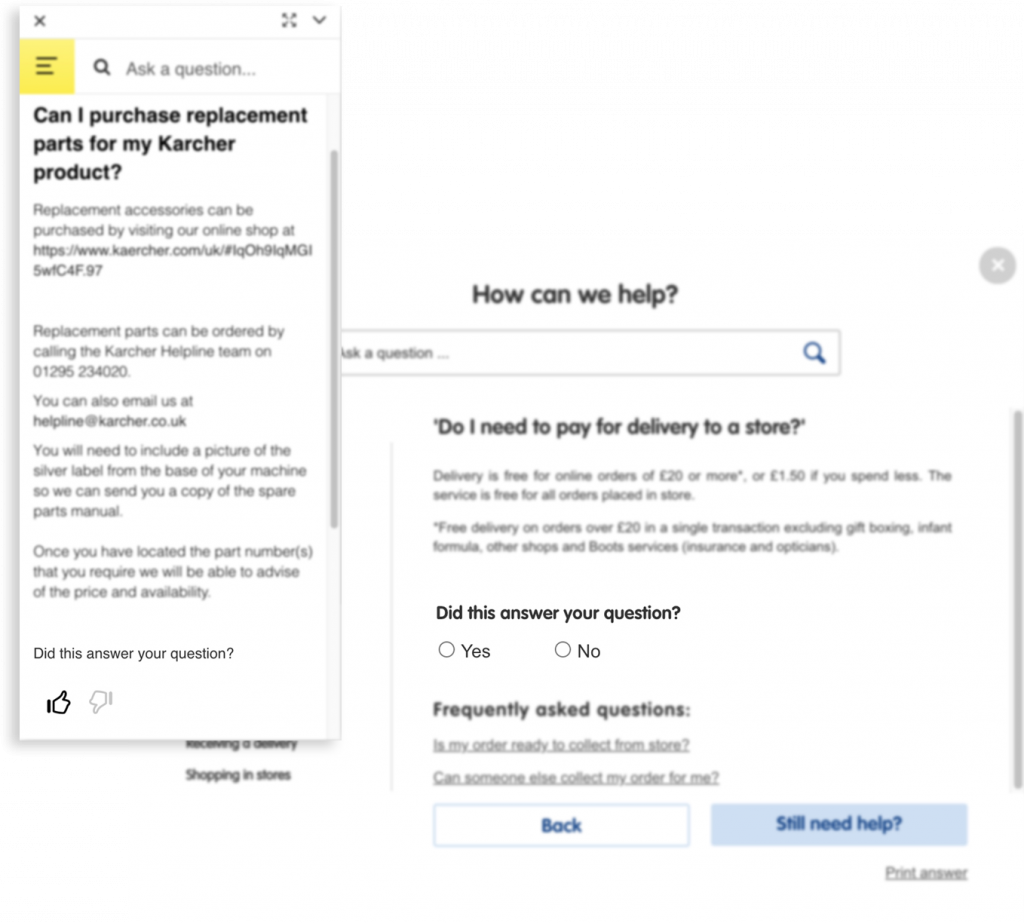
If companies want to retain customers by offering them great a customer service experience, whilst benefitting from a multitude of operational wins, they should have a range of customer service offerings in place, including self-service technologies.
If you enjoyed this article and would like to know more about self-service software or require help implementing self-service software, please
